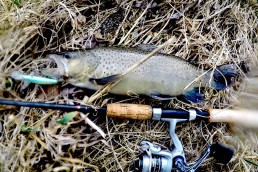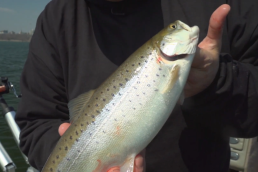The Cuyuna Connection to Put-and-Take Trout
SHARE THIS POST
Opening Day of the fishing season is both a tradition and treasure for Minnesota anglers. The second Saturday in May, lakes and rivers come alive with fishermen in pursuit of walleyes and northern pike. Those who prefer simpler opportunities fish channels and bays for crappies and bluegills. With the bass and muskie seasons still closed for a few more weeks, walleyes, pike and panfish get all the angling attention.
Or do they?
What if we told you about another option that combines “opening day anticipation” with simple tactics anyone can use to put loads of fish in the boat? Or on shore–because you don’t necessarily need a boat to catch them!
All across the country, stocked trout lakes provide superb angling opportunities for folks on a budget. In many cases, you can easily catch trout from shore, particularly in spring. In others, a small boat, easily launchable at primitive boat accesses, may provide a better option. Particularly during summer, when trout move deeper to avoid warm surface water that stresses their metabolism.
Strip pits, mine pits, borrow pits and other relatively small manmade waters are often top candidates for stocking with trout, particularly if they feature extremely deep water and steep shorelines. Such waters tend to remain cold and oxygen-rich throughout the year, making them ideal trout habitat. Rainbow trout generally predominate in stockings, although other species may be used as well.
While trout seldom reproduce in these waters, they don’t have to. State fisheries agencies typically pull aerated tanker trucks up the shore during the cool spring or fall months and discharge large quantities of hatchery-raised fish. The first few days following their introduction, while trout are still becoming accustomed to their surroundings, don’t be surprised to find a large cluster of trout within a short distance of the boat launch.
That’s because…think about it…that’s where the tanker truck backed down the ramp, the fisheries folks opened the valve, and dumped hundreds or thousands of small trout through a hose down into the lake! If they did it just a day or two prior to the trout opener, which is common, the fish are still getting used to their new habitat, and likely haven’t moved very far at all.
Hatchery-raised fish haven’t seen lures before, and often find their first encounter with anglers to be their last. But that’s okay. Fisheries agencies often plan on and encourage the harvest of trout from these waters, since the fish aren’t going to reproduce anyway. Thus, the term put-and-take. They put ‘em in. You take ‘em out.
The Cuyuna connection
Lying just east of Brainerd, near Crosby, lies the southern end of the Cuyuna Range, a rugged landform characterized by reddish soil that betrays the presence of iron ore. Formerly home to a thriving mining industry, the land was systematically dug to extract iron ore in the early 1900s. Once the mines ran out, the craterous network of deep, steep-sided pits was abandoned. Eventually, they began to fill with water, the result of natural seepage from the surrounding aquifer.
The state of Minnesota opted to take advantage of what were essentially deep, cold, infertile manmade lakes by stocking them with trout and opening them to the public. The resulting fishery is remarkably good, yet surprisingly little-known by the masses. A contingent of local anglers accounts for most of the fishing pressure, along with a smattering of Brainerd folks, particularly early in the season. The rest of the year, the fish receive comparatively little fishing activity, likely due to the vast number of better-known walleye-pike-bass-panfish waters in the area.
The upshot is, “the pits,” as they’re referred to locally, offer numerous fishing opportunities, and you don’t need a big, fancy boat to fish them. Chances are you can walk down to the boat access, and scramble your way a bit up and down the shoreline, to find suitable casting positions. Just be careful with your footing: The pits are steep and deep, with shorelines plunging to remarkably deep water just offshore. Stick to flatter, sloping shoreline sections to avoid rockslides that might put a damper on your fishing.
Perhaps even better would be using a small cartopper, canoe, kayak, inflatable or trailered boat—although admittedly, you can get a larger craft into most of the boat accesses. You just don’t need one. Because even on days when the wind is howling and whipping the waters of local lakes to a froth, the towering rock walls surrounding the pits deflect the wind to keep the water comparatively calm. Small boats are perfectly safe and extremely effective.
In short, it’s the perfect place to take a spouse and a kid or two to fish for a couple of hours. The pits are close to home, wind-protected, and loaded with what you might term “dumb” fish that are likely to bite anything of edible size that comes nearby.
Here’s why: Because they’ve been raised in hatcheries, stocker trout are used to eating something akin to Purina trout chow. So as soon as they’re dumped into new waters, they’re ready, willing and unafraid to eat whatever comes their way. A smorgasbord of insects, larvae, minnows and small fish are suddenly on the menu. And after their short lifetime of dining on trout nuggets, it’s a pleasant change. So the fish basically chow down on anything that moves–including small lures that resemble any of the aforementioned food items.
Trout tackle
While you can certainly bring your fly rod and pleasantly wile away the hours flicking teeny dry flies, streamers or nymphs for trout, you don’t have to. The fish are usually willing to strike almost anything that fits in their mouths. And sometimes, it seems that the flashier the lures, the more fish you catch.
In lake environments, small lures provide flashy, shiny morsels that these unwitting and enthusiastic trout can’t resist. Size #1 straight-shaft spinners, 1/4- to 3/5-ounce spoons and miniature crankbaits are ideal. So are the same 1/32- ounce jig & bobber combos that your fish for spring crappies. In fact, if you simply bring your crappie tackle, you’re in the game. Add a couple of 6 1/2-foot, medium-light spinning rods spooled with 6- to 8-pound-test mono—typical crappie setups. You’ll be able to cast in any direction, anywhere you wish, and work the surface layer of water. Which is a good deal early in the year, because most of the fish are likely to remain near the surface given the cool water temperatures.
Casting bobber rigs is deadly—but it’s a slow technique that limits your ability to cover water. If you use artificial lures that allow you to fish faster, you’ll be far more efficient at locating areas of the pit filled with biters.
Perhaps the easiest way to get started is to ease your boat 10 feet off the access, start the engine, and begin trolling at idle speed. Pick a direction up or down the shoreline. As you do, cast out a small spinner, a miniature spoon, or even better, a 2- to 3-inch mini crankbait. (Storm and Rapala offer many good options). Just get it out 75 feet behind the boat, close the bail on your spinning reel, and troll along just fast enough to get your lure seductively wiggling and wobbling a few feet beneath the surface.
Given the fact that many of the newly stocked fish are likely still close to the access, you might get bit in the first minute of fishing! If you do, slow down, gingerly fight the fish in, and land it. At that point, either release it, or toss it in the livewell. Remember, there’s no pressure to release these guys; they’re stocked with the intention of being caught and eaten.
Are you enjoying this post?
You can be among the first to get the latest info on where to go, what to use and how to use it!
If you don’t catch fish right away, just keep on trolling along the shoreline, over perhaps 15 to 25 feet of water. Even if the fish aren’t right near the surface, they should be able to see your lures coming from a long distance away, due to the remarkable water clarity in early spring.
Experiment with a range of color patterns, from flashy silvers and golds, to bright chartreuse or clown or hot pink, to darker, more muted shades. Sooner or later, you’re going to get nailed, and begin establishing the productive pattern for the day. You’ll probably be surprised how hard these little beauties fight despite their relatively small size.
Best bet: Once you catch a fish or two, circle back and re-troll the area a few times. You’ll probably catch more. The fish may be clustered in a corner of the pit; near a point; above some flooded tree tops; outside tall, rooted weed growth; near some suspended baitfish—you won’t know for sure unless you look for the common characteristics that draw and holds them in productive areas. Chances are that they won’t be just everywhere.
While you don’t necessarily need a depth finder or GPS mapping unit, they’re certainly helpful. They reveal sunken trees, the presence and numbers of the trout themselves, and the depth at which they’re suspended. If you have a GPS, start punching in waypoints whenever you hook a fish. It won’t take long until the screen is loaded with clusters of waypoints in limited areas. It’s no coincidence, either.
Early in the year, shallow-running lures that run just 3 to 6 feet deep will likely be tops for trout. A few weeks later, as the water warms, you may need to switch to deeper divers as the trout begin dropping deeper.
By summer, temperature-sensitive trout may have dropped considerably deeper to avoid the warming surface waters. They can’t handle warm water, but they have no problem with the cooler depths. Deeper-running crankbaits may be more productive.
In fall, it’s not unusual to catch trout in 40 to 50 feet of water, on or near bottom. Or suspended anywhere between the surface and bottom. They have no problem moving up and down in the water column, and they establish depth preferences for the day based on sunlight penetration, weather and activity. Under these conditions, a heavy jigging lure like a #5 Jigging Rap is ideal, since you can jig it at any depth to zero in on the biters.
All the same size?
Some folks may say that the knock against fishing for stocked trout is that they’re all small, which is a legitimate observation. Most of the time, the fish are raised to somewhere around 12 inches in length, and then stocked. That’s efficient management based on the available funding.
Occasionally, however, the DNR may sneak in a few larger brood fish to keep you on your toes. Or perhaps a few big brown trout to surprise the heck out of you when they bite. And of course, any fish that don’t get caught and harvested the first year are likely to grow a bit larger by the next, so you never know what you might catch.
But here’s the real wild card. The pits are home to some of the biggest largemouth bass and northern pike in our area. They may not be plentiful in number, but 7-pound bass and 20-pound pike never are, anywhere.
So…how and why do they grow so outlandishly large? Think about what they’re eating. Ah…you guessed it. Trout! A 12-inch, soft-finned trout slides down the gullet of a big bass or pike just like butter, and piles on the pounds in the process.
So, the next time you go trout fishing…you might want to toss in a little bass and pike tackle as well. Casting a 10-inch softbait in a rainbow trout pattern might be right up your alley.
Those flooded or fallen trees you see just might be home to a leviathan or two. The fish may not be actively biting on bright, sunny days when they can see so well in the crystal-clear water. But on cloudy days, look out! That’s when the monsters come out to play.
Hopefully, all this talk of consistent action with a chance at catching lunkers has tempted you to explore the pit fishing opportunities available in our area. If you do, you’ll have to decide whether or not to share the secret, or to keep it to yourself.
In any case, the next time someone asks you what the fishing is like between Brainerd and Crosby, just put a silly smirk on your face, shrug your shoulders, and say, “It’s the pits.” They can figure the rest out for themselves.
Note: Anglers age 18 thru 65 are required to purchase a trout stamp in addition to their regular Minnesota fishing license in order to fish for trout in inland lakes, streams and Lake Superior. No live minnows are allowed as bait in designated trout lakes.
For more information…
.dnr.state.mn.us/index.html
MWO
SHARE THIS POST
Did you enjoy this post?
You can be among the first to get the latest info on where to go, what to use and how to use it!
Dave Csanda
Dave Csanda has enjoyed 40 years in the fishing communications industry at In-Fisherman, Angling Edge and now, as editor of MidWest Outdoors. He is an inductee of both the Minnesota and National Fresh Water Fishing Halls of Fame.



